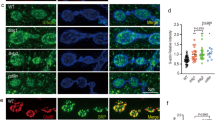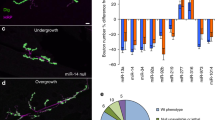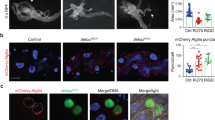Abstract
The evolutionarily conserved Highwire (Hiw)/Drosophila Fsn E3 ubiquitin ligase complex is required for normal synaptic morphology during development and axonal regeneration after injury. However, little is known about the molecular mechanisms that regulate the Hiw E3 ligase complex. Using tandem affinity purification techniques, we identified Drosophila Rae1 as a previously unknown component of the Hiw/Fsn complex. Loss of Rae1 function in neurons results in morphological defects at the neuromuscular junction that are similar to those seen in hiw mutants. We found that Rae1 physically and genetically interacts with Hiw and restrains synaptic terminal growth by regulating the MAP kinase kinase kinase Wallenda. Moreover, we found that the Rae1 is both necessary and sufficient to promote Hiw protein abundance, and it does so by binding to Hiw and protecting Hiw from autophagy-mediated degradation. These results describe a previously unknown mechanism that selectively controls Hiw protein abundance during synaptic development.
This is a preview of subscription content, access via your institution
Access options
Subscribe to this journal
Receive 12 print issues and online access
$209.00 per year
only $17.42 per issue
Buy this article
- Purchase on Springer Link
- Instant access to full article PDF
Prices may be subject to local taxes which are calculated during checkout








Similar content being viewed by others
References
Po, M.D., Hwang, C. & Zhen, M. PHRs: bridging axon guidance, outgrowth and synapse development. Curr. Opin. Neurobiol. 20, 100–107 (2010).
DiAntonio, A. et al. Ubiquitination-dependent mechanisms regulate synaptic growth and function. Nature 412, 449–452 (2001).
Wan, H.I. et al. Highwire regulates synaptic growth in Drosophila. Neuron 26, 313–329 (2000).
Uthaman, S.B., Godenschwege, T.A. & Murphey, R.K. A mechanism distinct from highwire for the Drosophila ubiquitin conjugase bendless in synaptic growth and maturation. J. Neurosci. 28, 8615–8623 (2008).
Schaefer, A.M., Hadwiger, G.D. & Nonet, M.L. rpm-1, a conserved neuronal gene that regulates targeting and synaptogenesis in C. elegans. Neuron 26, 345–356 (2000).
Zhen, M., Huang, X., Bamber, B. & Jin, Y. Regulation of presynaptic terminal organization by C. elegans RPM-1, a putative guanine nucleotide exchanger with a RING-H2 finger domain. Neuron 26, 331–343 (2000).
Bloom, A.J., Miller, B.R., Sanes, J.R. & DiAntonio, A. The requirement for Phr1 in CNS axon tract formation reveals the corticostriatal boundary as a choice point for cortical axons. Genes Dev. 21, 2593–2606 (2007).
Burgess, R.W. et al. Evidence for a conserved function in synapse formation reveals Phr1 as a candidate gene for respiratory failure in newborn mice. Mol. Cell Biol. 24, 1096–1105 (2004).
D'Souza, J. et al. Formation of the retinotectal projection requires Esrom, an ortholog of PAM (protein associated with Myc). Development 132, 247–256 (2005).
Culican, S.M., Bloom, A.J., Weiner, J.A. & DiAntonio, A. Phr1 regulates retinogeniculate targeting independent of activity and ephrin-A signaling. Mol. Cell. Neurosci. 41, 304–312 (2009).
Lewcock, J.W., Genoud, N., Lettieri, K. & Pfaff, S.L. The ubiquitin ligase Phr1 regulates axon outgrowth through modulation of microtubule dynamics. Neuron 56, 604–620 (2007).
Yan, D., Wu, Z., Chisholm, A.D. & Jin, Y. The DLK-1 kinase promotes mRNA stability and local translation in C. elegans synapses and axon regeneration. Cell 138, 1005–1018 (2009).
Xiong, X. et al. Protein turnover of the Wallenda/DLK kinase regulates a retrograde response to axonal injury. J. Cell Biol. 191, 211–223 (2010).
Hammarlund, M., Nix, P., Hauth, L., Jorgensen, E.M. & Bastiani, M. Axon regeneration requires a conserved MAP kinase pathway. Science 323, 802–806 (2009).
Scholich, K., Pierre, S. & Patel, T.B. Protein associated with Myc (PAM) is a potent inhibitor of adenylyl cyclases. J. Biol. Chem. 276, 47583–47589 (2001).
Guo, Q., Xie, J., Dang, C.V., Liu, E.T. & Bishop, J.M. Identification of a large Myc-binding protein that contains RCC1-like repeats. Proc. Natl. Acad. Sci. USA 95, 9172–9177 (1998).
Garbarini, N. & Delpire, E. The RCC1 domain of protein associated with Myc (PAM) interacts with and regulates KCC2. Cell Physiol. Biochem. 22, 31–44 (2008).
Abrams, B., Grill, B., Huang, X. & Jin, Y. Cellular and molecular determinants targeting the Caenorhabditis elegans PHR protein RPM-1 to perisynaptic regions. Dev. Dyn. 237, 630–639 (2008).
Wu, C., Wairkar, Y.P., Collins, C.A. & DiAntonio, A. Highwire function at the Drosophila neuromuscular junction: spatial, structural, and temporal requirements. J. Neurosci. 25, 9557–9566 (2005).
Liao, E.H., Hung, W., Abrams, B. & Zhen, M. An SCF-like ubiquitin ligase complex that controls presynaptic differentiation. Nature 430, 345–350 (2004).
Wu, C., Daniels, R.W. & DiAntonio, A. DFsn collaborates with Highwire to down-regulate the Wallenda/DLK kinase and restrain synaptic terminal growth. Neural Dev. 2, 16 (2007).
Saiga, T. et al. Fbxo45 forms a novel ubiquitin ligase complex and is required for neuronal development. Mol. Cell. Biol. 29, 3529–3543 (2009).
Collins, C.A., Wairkar, Y.P., Johnson, S.L. & DiAntonio, A. Highwire restrains synaptic growth by attenuating a MAP kinase signal. Neuron 51, 57–69 (2006).
Nakata, K. et al. Regulation of a DLK-1 and p38 MAP kinase pathway by the ubiquitin ligase RPM-1 is required for presynaptic development. Cell 120, 407–420 (2005).
Shen, W. & Ganetzky, B. Autophagy promotes synapse development in Drosophila. J. Cell Biol. 187, 71–79 (2009).
Brown, J.A. et al. A mutation in the Schizosaccharomyces pombe rae1 gene causes defects in poly(A)+ RNA export and in the cytoskeleton. J. Biol. Chem. 270, 7411–7419 (1995).
Pritchard, C.E., Fornerod, M., Kasper, L.H. & van Deursen, J.M. RAE1 is a shuttling mRNA export factor that binds to a GLEBS-like NUP98 motif at the nuclear pore complex through multiple domains. J. Cell Biol. 145, 237–254 (1999).
Jeganathan, K.B., Malureanu, L. & van Deursen, J.M. The Rae1-Nup98 complex prevents aneuploidy by inhibiting securin degradation. Nature 438, 1036–1039 (2005).
Sitterlin, D. Characterization of the Drosophila Rae1 protein as a G1 phase regulator of the cell cycle. Gene 326, 107–116 (2004).
Kraemer, D., Dresbach, T. & Drenckhahn, D. Mrnp41 (Rae1p) associates with microtubules in HeLa cells and in neurons. Eur. J. Cell Biol. 80, 733–740 (2001).
Rigaut, G. et al. A generic protein purification method for protein complex characterization and proteome exploration. Nat. Biotechnol. 17, 1030–1032 (1999).
McCabe, B.D. et al. Highwire regulates presynaptic BMP signaling essential for synaptic growth. Neuron 41, 891–905 (2004).
Conne, B., Stutz, A. & Vassalli, J.D. The 3′ untranslated region of messenger RNA: a molecular 'hotspot' for pathology? Nat. Med. 6, 637–641 (2000).
Bolognani, F. & Perrone-Bizzozero, N.I. RNA-protein interactions and control of mRNA stability in neurons. J. Neurosci. Res. 86, 481–489 (2008).
Levine, B. & Kroemer, G. Autophagy in the pathogenesis of disease. Cell 132, 27–42 (2008).
Pierre, S.C., Hausler, J., Birod, K., Geisslinger, G. & Scholich, K. PAM mediates sustained inhibition of cAMP signaling by sphingosine-1-phosphate. EMBO J. 23, 3031–3040 (2004).
Murthy, V. et al. Pam and its ortholog highwire interact with and may negatively regulate the TSC1.TSC2 complex. J. Biol. Chem. 279, 1351–1358 (2004).
Grill, B. et al. C. elegans RPM-1 regulates axon termination and synaptogenesis through the Rab GEF GLO-4 and the Rab GTPase GLO-1. Neuron 55, 587–601 (2007).
Johansen, T. & Lamark, T. Selective autophagy mediated by autophagic adapter proteins. Autophagy 7, 279–296 (2011).
Candiano, G. et al. Blue silver: a very sensitive colloidal Coomassie G-250 staining for proteome analysis. Electrophoresis 25, 1327–1333 (2004).
Wairkar, Y.P. et al. Unc-51 controls active zone density and protein composition by downregulating ERK signaling. J. Neurosci. 29, 517–528 (2009).
Scott, R.C., Juhasz, G. & Neufeld, T.P. Direct induction of autophagy by Atg1 inhibits cell growth and induces apoptotic cell death. Curr. Biol. 17, 1–11 (2007).
Petersen, S.A., Fetter, R.D., Noordermeer, J.N., Goodman, C.S. & DiAntonio, A. Genetic analysis of glutamate receptors in Drosophila reveals a retrograde signal regulating presynaptic transmitter release. Neuron 19, 1237–1248 (1997).
Loureiro, J. & Peifer, M. Roles of Armadillo, a Drosophila catenin, during central nervous system development. Curr. Biol. 8, 622–632 (1998).
Daniels, R.W. et al. A single vesicular glutamate transporter is sufficient to fill a synaptic vesicle. Neuron 49, 11–16 (2006).
Tian, X. et al. RAB26 and RAB3D are direct transcriptional targets of MIST1 that regulate exocrine granule maturation. Mol. Cell. Biol. 30, 1269–1284 (2010).
Acknowledgements
We are particularly grateful to D. Sitterlin for providing the antibody to Rae1. We would like to thank the A.J. Siteman Cancer Center at the Washington University School of Medicine and Barnes-Jewish Hospital in St. Louis, Missouri, and the Department of Physiology at the Louisiana State University Health Sciences Center in New Orleans for the use of their proteomic core facilities. We are grateful to T. Neufeld and the Bloomington Stock Center for fly stocks, and the Developmental Studies Hybridoma Bank for antibodies. We also thank B. Grill and Y. Jin for helpful comments. This work is supported by grants from the US National Institutes of Health (NS070962 to C.W. and DA020812 to A.D.).
Author information
Authors and Affiliations
Contributions
C.W. and A.D. initiated the project and conducted the Hiw structure and function analysis. C.W. directed the rest of the studies. X.T. and C.W. conceived and designed the experiments. X.T., J.L. and C.W. performed the experiments. V.V. contributed to the characterization of the Rae1 mutant phenotype. C.W. and X.T. wrote the manuscript with input from A.D.
Corresponding author
Ethics declarations
Competing interests
The authors declare no competing financial interests.
Supplementary information
Supplementary Text and Figures
Supplementary Figures 1–13, and Supplementary Tables 1 and 2 (PDF 5492 kb)
Rights and permissions
About this article
Cite this article
Tian, X., Li, J., Valakh, V. et al. Drosophila Rae1 controls the abundance of the ubiquitin ligase Highwire in post-mitotic neurons. Nat Neurosci 14, 1267–1275 (2011). https://doi.org/10.1038/nn.2922
Received:
Accepted:
Published:
Issue Date:
DOI: https://doi.org/10.1038/nn.2922
This article is cited by
-
Autophagy is inhibited by ubiquitin ligase activity in the nervous system
Nature Communications (2019)
-
Genome-Wide Association Study of Circadian Behavior in Drosophila melanogaster
Behavior Genetics (2019)
-
Drosophila Studies on Autism Spectrum Disorders
Neuroscience Bulletin (2017)
-
The PHR proteins: intracellular signaling hubs in neuronal development and axon degeneration
Neural Development (2016)
-
Autophagy in synaptic development, function, and pathology
Neuroscience Bulletin (2015)



